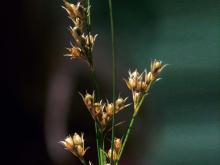Wildflowers, Grasses and Other Nonwoody Plants
Media

Species Types
Scientific Name
Agalinis tenuifolia (formerly Gerardia tenuifolia)
Description
Slender false foxglove, or common gerardia, is a small, showy wildflower with slender, opposite leaves and thin, wiry, branching stems. The small, funnel-shaped blossoms are pink or purple, with an upper lip that arches over the 4 hairy stamens.
Media

Species Types
Scientific Name
Polygala sanguinea
Description
The dense, cylindrical flower clusters of field milkwort are pink to white and, at first glance, look something like a clover head. This small annual wildflower is common in prairies, old fields, meadows, and glades.
Media

Species Types
Scientific Name
Solidago ptermicoides (formerly Aster ptarmicoides)
Description
With its white, petal-like ray florets and pale disc florets, upland white goldenrod is truly the oddball of the goldenrods: it looks like a white-flowered aster. Indeed, it used to be considered an aster.
Media

Species Types
Scientific Name
Juncus spp. and Luzula spp.
Description
Missouri has 24 species in the rush family. Distinguishing between these grasslike plants can be tricky, but it’s easy to learn some basics about the group.
Media

Species Types
Scientific Name
Carex, Schoenoplectus, Scirpus, and other genera
Description
Missouri has more than 200 species in the sedge family. Distinguishing between these grasslike plants can be difficult, but it’s easy to learn some basics about the group.
Media

Species Types
Scientific Name
Symphyotrichum spp. (formerly Aster spp.)
Description
Missouri has 24 species of New World asters in genus Symphyotrichum. Most have purple or white ray flowers and yellow disk flowers that turn reddish over time. Most bloom in late summer and fall.
Media

Species Types
Scientific Name
Liatris spp.
Description
Missouri boasts nine native species of blazing stars, or gayfeathers, in genus Liatris. These showy, upright, unbranching spikes of magenta-pink wildflowers bloom in sunny habitats.
Media

Species Types
Scientific Name
Liatris cylindracea
Description
Cylindrical blazing star is one of several Missouri native species of blazing stars, or gayfeathers. It is widely scattered in the Ozarks and eastern Missouri. Identify it by its bracts, which are pressed against the base of the flowerhead, accentuating its cylindrical look.
Media

Species Types
Scientific Name
Liatris squarrosa (syn. L. hirsuta, in part)
Description
Scaly blazing star is one of several Missouri native species of blazing stars, or gayfeathers. It is scattered nearly statewide. Identify it by its long-pointed flowerhead bracts that spread or curl sharply away.
Media

Species Types
Scientific Name
Erythronium mesochoreum
Description
Prairie dogtooth violet, or prairie trout lily, is a small, early blooming lily that lives in prairies and glades. Its flowers are white and its narrow leaves are folded lengthwise and seem waxy on the undersurface.
See Also
About Wildflowers, Grasses and Other Nonwoody Plants in Missouri
A very simple way of thinking about the green world is to divide the vascular plants into two groups: woody and nonwoody (or herbaceous). But this is an artificial division; many plant families include some species that are woody and some that are not. The diversity of nonwoody vascular plants is staggering! Think of all the ferns, grasses, sedges, lilies, peas, sunflowers, nightshades, milkweeds, mustards, mints, and mallows — weeds and wildflowers — and many more!





















